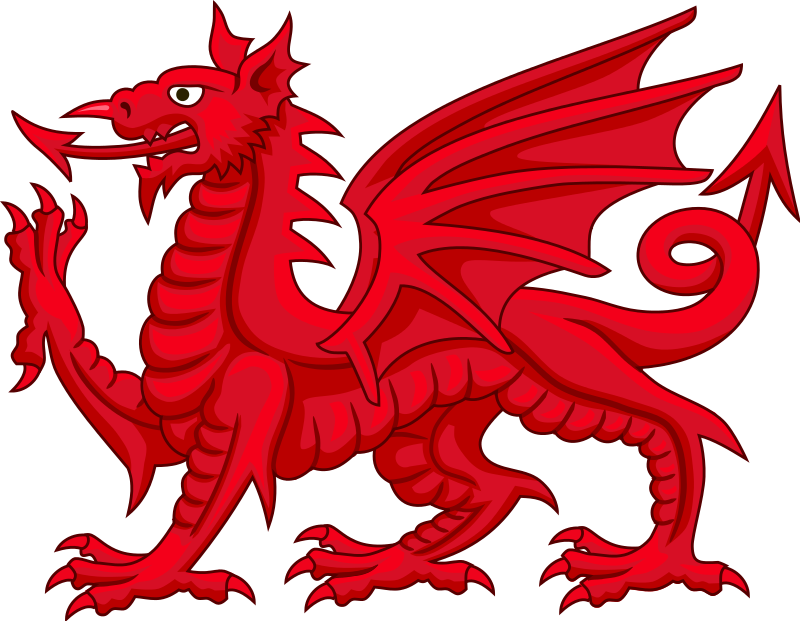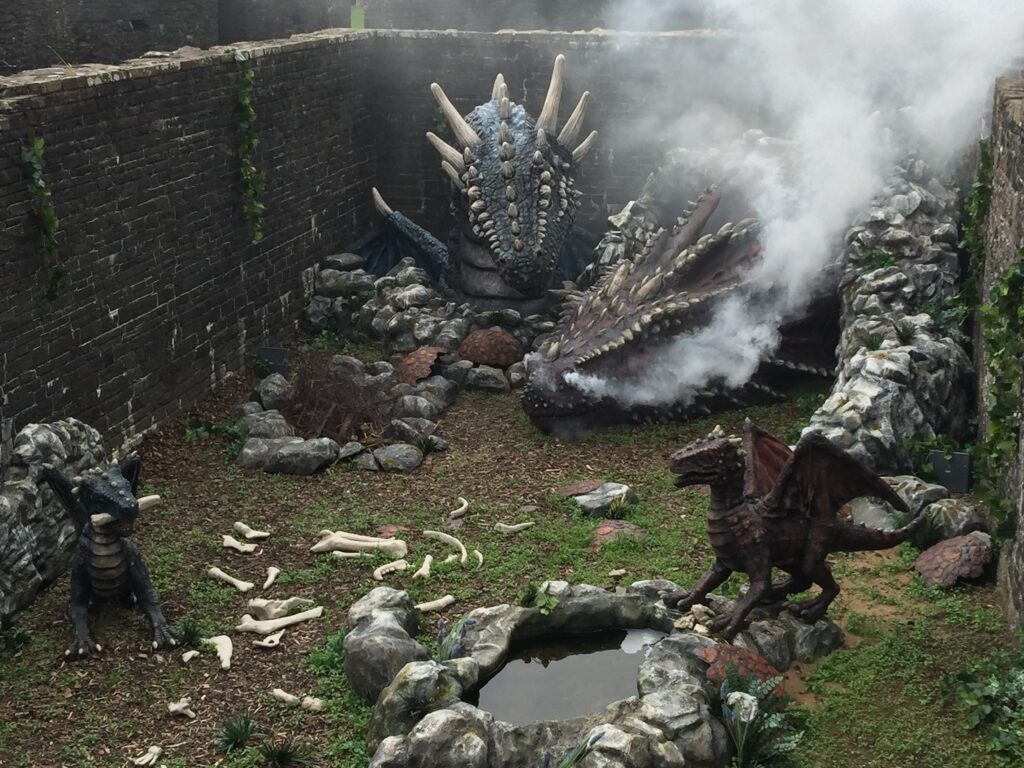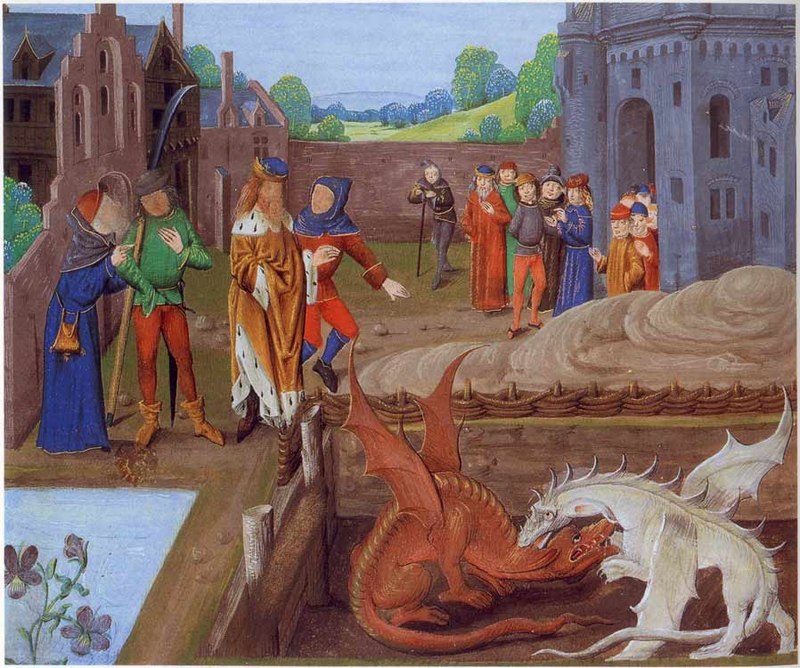The Welsh Dragon

THE Welsh Dragon (Y Ddraig Goch) is a heraldic symbol which emerged from ancient mystical and legendary beginnings to appear on the national flag of Wales.
Wales is just one of three countries globally that have a dragon on the national flag. It was only allowed official status in 1959, but has since topped polls as the world’s ‘coolest’ flag.
It is a familiar sight everywhere in Wales, but what is the story of the Welsh dragon? Why does Wales carry a red dragon on its flag and how did it become associated with the country?
The dragon itself is named Dewi (or ‘David’ – after the patron saint of Wales). This is derived from the Great Red Serpent that once represented the old Welsh dragon god Dewi.
Despite the fact that Western/European dragons were portrayed as evil and malevolent creatures that were greedy, tyrannical, and often represented the darker side of humanity, the Welsh Dragon was an exception to the rule – being shown as a fierce creature but a benevolent one. It has remained synonymous with Welsh culture and identity.
Through the Roman occupation of the UK, the Roman cavalry is believed to have worn a dragon emblem on their pennants and standards. ‘Draco’ standards were used between 250 and 400 AD and were typically carried by cavalry units.

It is considered that the Welsh kings of Aberffraw first adopted the dragon in the early 5th Century in order to symbolise their power and authority after the Romans withdrew from Britain. Later, around the 7th Century, it became known as the Red Dragon of Cadwaladr, king of Gwynedd from 655 to 682.
Geoffrey of Monmouth in his Historia Regum Britanniae, written between 1120 and 1129, links the dragon with the Arthurian legends, including Uther Pendragon, the father of Arthur, whose name translates as ‘Dragon Head’.
Geoffrey’s account also tells of the prophecy of Myrddin (or Merlin) and a long fight between a red dragon and a white dragon, symbolising the historical struggle between the Welsh (red dragon) and the English (white dragon).
Beddgelert, a village and community in the Snowdonia area of Gwynedd, north Wales, is the setting for the celebrated legend of Dinas Emrys, the lofty mountain home of the dragon seen fluttering on Welsh flags.
In the Mabinogion story Lludd and Llefelys, a red dragon battles with an invading white dragon, whose pained shrieks cause women to miscarry, animals to perish and plants to become barren. Lludd, king of Britain, goes to his wise brother Llefelys in France for help.
Llefelys tells him to dig a pit in the centre of Britain, fill it with mead, and cover it with cloth. Lludd does this, and the dragons drink the mead and fall asleep. Lludd imprisons them, still wrapped in their cloth, in Dinas Emrys.
The tale is taken up in the Historia Brittonum; the dragons remain at Dinas Emrys for centuries until King Vortigern tries to build a castle there. Every night the castle walls and foundations are demolished by unseen forces. Vortigern consults his advisers, who tell him to find a boy with no natural father, and sacrifice him.
A search was launched and eventually the child was found in Caer Myrddin (Carmarthen) and preparations for the sacrifice were made. But the child, Myrddin Emrys, was no ordinary child. In fact, he was Merlin, the wizard.
On hearing that he is to be put to death to end the demolition of the walls, the boy is dismissive of the advice, and tells the king about the two dragons. Vortigern excavates the hill, freeing the dragons. They continue their fight and the red dragon finally defeats the white dragon.

The boy tells Vortigern that the white dragon symbolises the Saxons and that the red dragon symbolises the people of Vortigern. If Vortigern is accepted to have lived in the 5th Century, then these people are the British whom the Saxons failed to subdue and who became the Welsh.
Vortigern’s castle was finally built and duly named Dinas Emrys in honour of Myrddin Emrys, and the red dragon has been celebrated ever since.
Intriguingly, In 1945, the site was excavated by archaeologists who discovered a lake and the ruins of the fortress dating to Vortigern’s time. The walls all showed signs of having been rebuilt several times.
The oldest recorded use of the dragon to symbolise Wales is in the Historia Brittonum, written around AD 829, but it is popularly supposed to have been the battle standard of King Arthur and other ancient Celtic leaders.
Centuries later, Owain Glyndŵr raised the dragon through his revolt against Henry IV, echoing its role in Welsh mythology as a symbol of resistance.
Owain Glyndŵr’s banner was known as Y Ddraig Aur or ‘The Golden Dragon’. It was famously raised over Caernarfon during the Battle of Tuthill in 1401 against the English.
The dragon was brought to England by the House of Tudor, the Welsh dynasty that held the English throne from 1485 to 1603. It signified their direct descent from one of the noble families of Wales. The green and white stripes of the flag were additions of Henry VII, the first Tudor king, representing the colours of his standard.
During Henry VIII’s reign the red dragon on a green and white background became a favourite emblem on Royal Navy ships.
Though the dragon faded in popularity somewhat and wasn’t featured on the Union Flag of 1606, the red dragon appears to have regained popularity in the early part of the 20th Century, when it was used for the 1911 Caernarfon Investiture of Edward, Prince of Wales.

It wasn’t until 1959, however, that it became officially recognised as the national flag of the country when Queen Elizabeth declared that “only the Red Dragon on a green and white flag should be flown on government buildings in Wales”.
Indeed, the Welsh Dragon is one of the ‘Queen’s Beasts’ – a set of 10 heraldic statues depicting the genealogy of Queen Elizabeth II.
The Red Dragon now flies proudly over public and private buildings throughout Wales and thousands still cross the border into England every other year, when the two nations renew their great rivalry on the rugby battlefield known as Twickenham. Welshmen, women and children carry the dragon and have them painted on their faces as a symbol of pride in their history and culture.
Welsh singer Shirley Bassey famously wore a dress with the Welsh flag on during the opening ceremony for the 1999 Rugby World Cup, hosted by Wales, while other Welsh singing stars, such as Katherine Jenkins and Cerys Matthews, have worn the image of the Welsh flag while performing on stage.

In 2007, Reverend George Hargreaves – the party leader of the Welsh Christian Party – tried to replace the flag of the Welsh dragon with the flag of St David by stating that the Welsh dragon was “demonic” and that it was at odds with Wales’s position as a Christian nation.
However, the attempt failed – with members of the public (including historians and other Christians) pointing out that the dragon is a historical symbol and very few would ever see it as the image of the devil.
Following the first Battle of the Somme in which 4,000 soldiers in the 38th Welsh Division were killed or wounded in the historic attack on Mametz Wood in France in 1916, a publicly-funded memorial with the Welsh dragon on top was built in 1987 and later refurbished in 2013 in time for the 100th anniversary of the battle.
In Wrexham, a project known as ‘Waking the Dragon’ (Deffro’r Ddraig) set out to build a cultural heritage centre in Wrexham with an 80ft tall bronze statue of the Welsh dragon on top of it. The centre aimed to be a hub for business, leisure and tourism – showcasing Welsh cuisine, art and Welsh heritage.
Like all good myths and legends, there is a prophecy relating to the Welsh Dragon. It states that when Wales comes to face its darkest hour, the Welsh Dragon will awaken from its slumber to defend the nation.